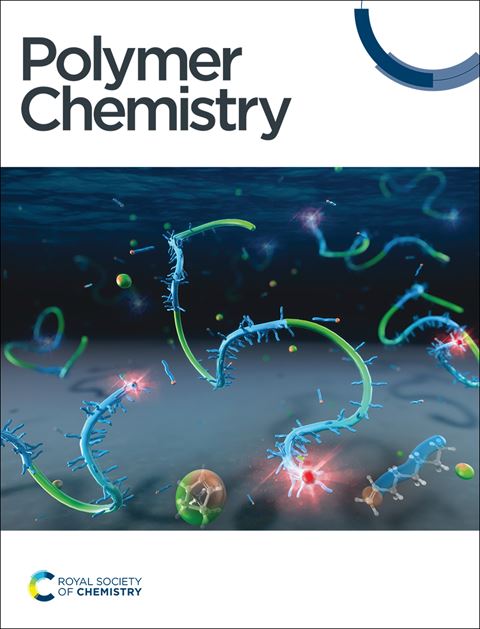Self-driving laboratory platform for many-objective self-optimisation of polymer nanoparticle synthesis with cloud-integrated machine learning and orthogonal online analytics†
IF 3.9
2区 化学
Q2 POLYMER SCIENCE
引用次数: 0
Abstract
The application of artificial intelligence and machine learning is revolutionising the chemical industry, with the ability to automate and self-optimise reactions facilitating a step change in capability. Unlike small-molecules, polymer nanoparticles require navigation of a more complex parameter space to access the desired performance. In addition to the chemical reaction, it is desirable to optimise the polymer molecular weight distribution, particle size and polydispersity index. To solve this many-objective optimisation problem, a self-driving laboratory is constructed which synthesises and characterises polymer nanoparticles (incorporating NMR spectroscopy, gel permeation chromatography and dynamic light scattering). This facilitates the autonomous exploration of parameter space with programmable screens or AI driven optimisation campaigns via a cloud-based framework. The RAFT polymerisation of diacetone acrylamide mediated by a poly(dimethylacrylamide) macro-CTA was optimised to maximise monomer conversion, minimise molar mass dispersity, and target 80 nm particles with minimised polydispersity index. A full-factorial screen between 6- and 30-minutes residence time, between 68 and 80 °C and between 100 and 600 for the [monomer] : [CTA] ratio enabled mapping of the reaction space. This facilitated in-silico simulations using a range of algorithms – Thompson sampling efficient multi-objective optimisation (TSEMO), radial basis function neural network/reference vector evolutionary algorithm (RBFNN/RVEA) and multi objective particle swarm optimisation, hybridised with an evolutionary algorithm (EA-MOPSO), which were then applied to in-lab optimisations. This approach accounts for an unprecedented number of objectives for closed-loop optimisation of a synthetic polymerisation; and enabled the use of algorithms operated from different geographical locations to the reactor platform.

基于云集成机器学习和正交在线分析的多目标自优化聚合物纳米颗粒合成的自动驾驶实验室平台。
人工智能和机器学习的应用正在彻底改变化学工业,其自动化和自我优化反应的能力促进了能力的逐步变化。与小分子不同,聚合物纳米颗粒需要导航更复杂的参数空间才能获得所需的性能。除了化学反应外,还需要优化聚合物的分子量分布、粒径和多分散性指数。为了解决这一多目标优化问题,我们建立了一个自动驾驶实验室,用于合成和表征聚合物纳米颗粒(结合核磁共振波谱、凝胶渗透色谱和动态光散射)。这有助于通过基于云的框架使用可编程屏幕或AI驱动的优化活动自主探索参数空间。通过优化聚(二甲基丙烯酰胺)宏观cta介导的二丙酮丙烯酰胺RAFT聚合,以最大限度地提高单体转化率,最小化摩尔质量分散性,并以最小的多分散性指数靶向80 nm颗粒。对于[单体]:[CTA]比例,在6- 30分钟停留时间、68 - 80°C和100 - 600°C之间进行全因子筛选,可以绘制反应空间。这有助于使用一系列算法进行计算机模拟-汤普森采样高效多目标优化(TSEMO),径向基函数神经网络/参考向量进化算法(RBFNN/RVEA)和多目标粒子群优化,混合进化算法(EA-MOPSO),然后将其应用于实验室优化。这种方法为合成聚合的闭环优化提供了前所未有的目标数量;并且可以使用从不同地理位置运行到反应堆平台的算法。
本文章由计算机程序翻译,如有差异,请以英文原文为准。
求助全文
约1分钟内获得全文
求助全文
来源期刊

Polymer Chemistry
POLYMER SCIENCE-
CiteScore
8.60
自引率
8.70%
发文量
535
审稿时长
1.7 months
期刊介绍:
Polymer Chemistry welcomes submissions in all areas of polymer science that have a strong focus on macromolecular chemistry. Manuscripts may cover a broad range of fields, yet no direct application focus is required.
 求助内容:
求助内容: 应助结果提醒方式:
应助结果提醒方式:


